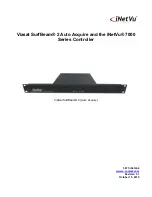
Product installation must be carried out in accordance with any local codes that may apply
and should only be carried out by a competent electrical engineer.
Location
:
The location of the unit should be made with due regard to the area over which the sounder
warning signal must be audible. The unit should only be fixed to services that can carry the
weight of the unit.
Mounting (Bracket Mounting)
:
The unit mounts via a ‘U’ shaped stainless steel bracket by using one 12mm diameter and
two 8.5mm diameter bolt holes in the centre of the bracket (see picture 1). The alignment
and positions can be adjusted by loosening the two M8 screws, which fastened the stainless
steel bracket to the sounder. The sounder should be positioned such that dust, debris or water
cannot enter into the horn opening.
6.0 Wiring
General Requirement:
Moflash recommends that all cables and cores should be fully
identified (suggest using cable from 2.0 to 2.5 mm²). Ensure that all nuts, bolts and screws
are secured. Ensure that only the right and certified cable glands are used and earthed
correctly. Ensure that only the right and certified stopping plugs are used to blank off unused
gland entry points. In order to maintain the IP rating of the product, we recommend SS316L
for this application.
Cable connection:
The cable connection is to terminals on the pcb located in the flameproof enclosure of the
sounder. Cable connection should be carried out to in accordance with relevant technical
requirement
(see picture 1).
For
AC supply
- connect to terminals marked ‘
L
’ & ‘
N
’.
Terminals provide loop in loop out facility.
For
DC supply
- connect ‘
+
’ to ‘
L
’ and ‘-‘ (0v) to ‘
N
’.
Alarm stages
- terminals ‘
S0
’ (common) ‘
S1 & S2
’
(refer to table overleaf).
Removal of End Cover
Unscrew the four (4) M5 retained hex socket head screws
(see diagram 2).
Twist the cover gently clockwise and
anti-clockwise, whilst pulling away from the body,
keeping the cover parallel to the body until it comes free.
This will allow the cover to hang on its retaining strap.
Before replacing the cover, check the flameproof
joints are clean and not damaged, the gasket is
retained in its groove.
Caution:
Before removing the cover ensure
the power to the sounder is isolated.
1.0 Introduction:
The SD125 Explosion Proof sounder is certified for use and installation in Zone
1 and Zone 2 areas with gas groups of IIA, IIB, IIC and temperature classification of T4~T6. It
specially applies to Oil & Gas, Offshore Platform, Chemical, Petrochemical, Refinery and Marine
Industries etc. Enclosure material is Stainless Steel. The sounder has 4 stage alarm tones which can
be sent out. 63 tones are selectable. Users can record sounds or customize sounds into the sounder
by using 5 spare tones. Tone can be present during installation.
2.0 Explosion Proof Labelling:
All products have a rating label with the following important information:
Product order no: eg SD1251BDCNNAR (Refer to the datasheet for product order selection)
Input voltage:
<
48v DC or 100-240v AC (50/60 Hz),
<20W
Code:
Ex d IIC T4~ T6 Gb, Ex tb IIIC T135
0
C~T85
0
C IP66
Nemko ATEX Certificate No:
Nemko 14 ATEX 1009X
ATEX Mark:
IECEx Certificate:
IECEx-NEM 14.0005X
Gas Group and Category:
II 2GD
CE Mark:
Mark No: 0518
Warning:
DO NOT OPEN WHEN AN EXPLOSIVE GAS ATMOSPHERE IS PRESENT
Finished product serial no (Include date of construction): ie. SD125-0201080001
SD125
-Stainless Steel Sounder,
Day
-02,
Month
-01,
Year
-08,
Product Serial Number
-0001
3.0 Type Approval Standard:
The SD125 series have an EC Type Examination Certificate
issued by
Nemko
and have been approved to the following standards:
EN 60079-0:2012 (IEC 60079-0:2011), EN-60079-1:2007 (IEC 60079-1:2007) and
EN 60079-31:2009 (IEC 60079-31:2008).
4.0 Zones, Gas Group, Category and Temperature Classification
The SD125 series have been certified Ex d IIC T4~T6.
This means that the units can be installed in locations
with the following conditions:
Area Classification
Zone 1:
Explosive gas air mixture likely to occur in normal operation.
Zone 2:
Explosive gas air mixture not likely to occur, and if it does,
it will only exist for a short time.
Gas Groupings:
Group IIA Propane Group,
IIB Ethylene Group and
IIC Hydrogen and Acetylene
Equipment Category:
2Gd
Temperature Range:
-40
0
C < Ta <70
0
C
5.0 Installation
General Requirement
: The product must be installed
in accordance with the latest issued relevant requirements
in the EN60079-0 and EN60079-1 specification or the
equivalent IEC specification- Selection, Installation
and Maintenance of electrical apparatus for use in
potentially explosive atmosphere.
Diagram 1
263.5
170.0
3.0
ø282.8
153.0
60.0
ø12.0
2-ø8.5
FIX HOLE
243.8
169.8
ø150.0
DIP Switch
Potentiometer
153.0
30.0
ø187.0
195.8
CABLE ENTRIES (x2)
4 - M5
SOCKET
SCREWS
L SO S2
N S1
DIP Switch
Potentiometer
L SO S2
N S1 DIY
Pause Button
Reset
Audio In
Recording
Button
263.5
170.0
3.0
ø282.8
153.0
60.0
ø12.0
2-ø8.5
FIX HOLE
243.8
169.8
ø150.0
DIP Switch
Potentiometer
153.0
30.0
ø187.0
195.8
CABLE ENTRIES (x2)
4 - M5
SOCKET
SCREWS
L SO S2
N S1
DIP Switch
Potentiometer
L SO S2
N S1 DIY
Pause Button
Reset
Audio In
Recording
Button
263.5
170.0
3.0
ø282.8
153.0
60.0
ø12.0
2-ø8.5
FIX HOLE
243.8
169.8
ø150.0
DIP Switch
Potentiometer
153.0
30.0
ø187.0
195.8
CABLE ENTRIES (x2)
4 - M5
SOCKET
SCREWS
L SO S2
N S1
DIP Switch
Potentiometer
L SO S2
N S1 DIY
Pause Button
Reset
Audio In
Recording
Button
263.5
170.0
3.0
ø282.8
153.0
60.0
ø12.0
2-ø8.5
FIX HOLE
243.8
169.8
ø150.0
DIP Switch
Potentiometer
153.0
30.0
ø187.0
195.8
CABLE ENTRIES (x2)
4 - M5
SOCKET
SCREWS
L SO S2
N S1
DIP Switch
Potentiometer
L SO S2
N S1 DIY
Pause Button
Reset
Audio In
Recording
Button
Diagram 2
Picture 1




















